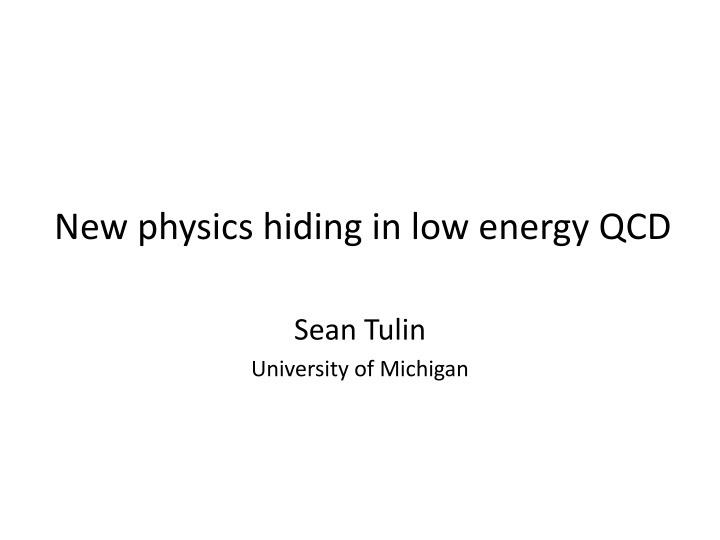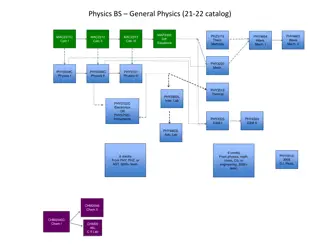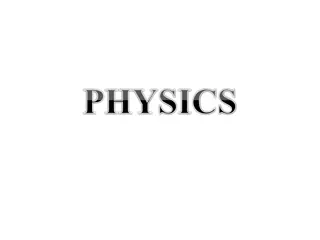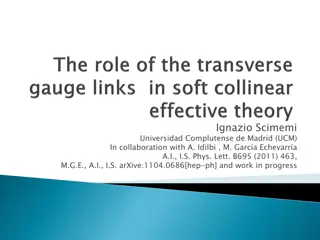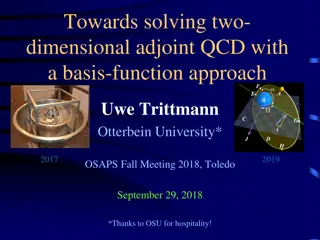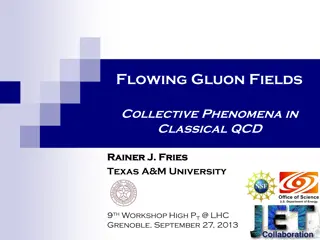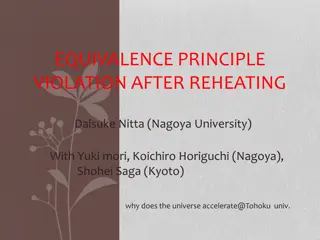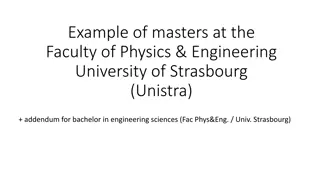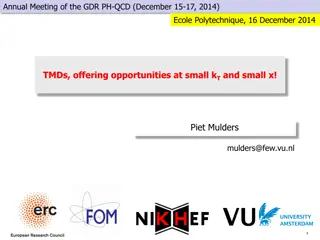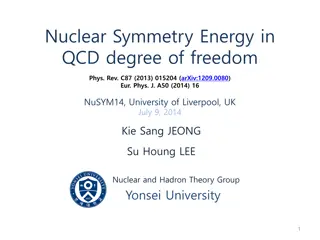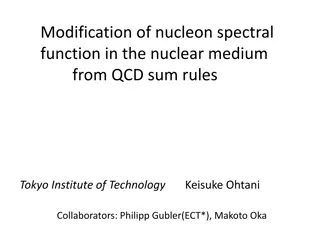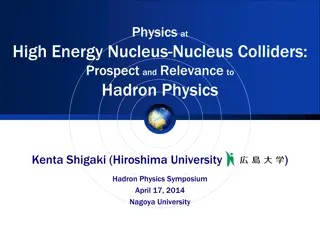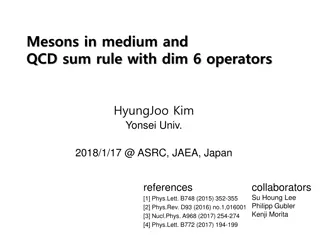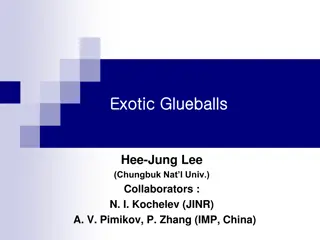CP Violation in Low-Energy QCD: New Physics Perspectives
Investigating CP violation in low-energy QCD, this presentation by Sean Tulin from the University of Michigan delves into the sensitivities of decays to new physics, focusing on CP violation beyond the Standard Model and the potential existence of new weakly-coupled light forces hiding under QCD. Discussing the motivation behind CP violation, current limits, neutron electric dipole moment constraints, and the implications for baryogenesis, the presentation explores the interplay between CP violation and new physics scenarios.
Download Presentation

Please find below an Image/Link to download the presentation.
The content on the website is provided AS IS for your information and personal use only. It may not be sold, licensed, or shared on other websites without obtaining consent from the author.If you encounter any issues during the download, it is possible that the publisher has removed the file from their server.
You are allowed to download the files provided on this website for personal or commercial use, subject to the condition that they are used lawfully. All files are the property of their respective owners.
The content on the website is provided AS IS for your information and personal use only. It may not be sold, licensed, or shared on other websites without obtaining consent from the author.
E N D
Presentation Transcript
New physics hiding in low energy QCD Sean Tulin University of Michigan
Outline Some thoughts on sensitivities of decays to new physics Two parts to this talk: CP violation beyond the standard model ( ) How do decays compare to EDM limits? New weakly-coupled light forces Are there new gauge forces hiding under QCD?
Part 1 CP violation and
CP violation (CPV): motivation Cosmology (baryon asymmetry): Sakharov conditions for baryogenesis (Sakharov 1967) 1. Baryon number violation 2. C- and CP-violation 3. Departure from equilibrium or CPT violation CP violation in the Standard Model (SM) insufficient to explain baryon asymmetry (Gavela et al 1993, Huet & Sather 1994) Particle physics CPV is a generic feature of particle physics theories beyond the SM e.g. Supersymmetry or neutrino see-saw models: theories have new phases that can give successful baryogenesis
CPV decay Current limit: BR( ) < 3.4 x 10-4 (GAMS-4 ) Standard model (Jarlskog & Shabalin 1995) CKM phase: QCDphase: BR( ) < 10-27 BR( ) < 10-18x ( QCD/10-10)2 Neutron electric dipole moment (EDM) constraint: (Crewther et al 1979, Pospelov & Ritz 1999; Baker et al 2006) dn = 2.4 x 10-16 e cm x QCD < 2.9 x 10-26 e cm [90% limit] Otherwise BR( ) could have been sizable in SM!
CPV decay BR( ) unambiguous probe for new CPV Caveat: Any contribution to BR( ) also generates a nonzero neutron EDM. Can use neutron EDM to limit BR( ). Gorchtein bound: (Gorchtein 2008) BR( ) 3.5 x 10-14for dn < 2.9 x 10-26 e cm
Gorchtein bound g CP-odd coupling = CPV vertex CP-odd NN coupling Integrate out pions N N CP-odd NN coupling Integrate out N N N N dn 2.5 x 10-17 e cm x (g /GeV) Order-of-magnitude estimate only (Gorchstein 2008)
Gorchtein bound (revisited?) Can this bound be made more rigorous? Some ideas g CP-odd coupling = CPV vertex CP-odd NN coupling Match onto -N EFT by integrating out Generate CP-odd (isoscalar) coupling. CP-odd NN coupling Match onto -N EFT by integrating out n EDM N N (Crewther et al 1979) N N
Conclusions: CPV decay BR( ) must be far below experimental sensitivities due to stringent n EDM limit: Current limit: dn < 2.9 x 10-26 e cm (Baker et al 2006) Gorchtein bound: BR( ) 3.5 x 10-14 Independent of particle physics model for new CPV Caveat: Bound is approximate (order of magnitude only) Worthwhile to revisit this bound to make it more precise BUT cannot avoid generating dn at two loop order: dn e g / ((4 )4 MQCD2) 10-18 e cm x (g /GeV) Very na ve estimate
Conclusions: CPV decay Another caveat: n EDM and BR( ) sensitive to different linear combinations of new physics CPV phases Can have fine-tuned cancellations between phases contributing to dn but not BR( ) 10-5 cancellation in dn BR 3.5 x 10-4 10-4 cancellation in dn BR 3.5 x 10-6 What is the constraint on BR( ) from dHg? Likely requires fine-tuning to evade dHg limit also BUT BR( ) should be measured anyway
Part 2 Searching for new light forces
Motivation for new forces SM based on SU(3)C x SU(2)L x U(1)Y gauge symmetry. Are there any additional gauge symmetries? Look for new gauge bosons. Motivations: 1. Grand unified theories: Generically have additional gauge bosons, but typically very heavy (1016 GeV). 2. Dark matter: Stability of dark matter related to new gauge symmetry? Intensity frontier -1 (1/coupling) LHC mass
Motivation for new forces New light (MeV GeV) forces associated with dark matter (DM) have received much attention in the past few years. Sommerfeld-enhancement models of DM and indirect detection anomalies (e.g. PAMELA) Self-interacting DM and explaining small scale structure anomalies in dwarf galaxies Asymmetric DM models Hidden sector DM and relic density (g-2) anomaly Pospelov (2008) Pospelov & Ritz (2008); Arkani-Hamed et al (2008) e.g. Lin et al (2011) Feng et al (2009) GeV-scale experimental searches for new weakly-coupled light vector bosons from a new force ( dark photon ) Bjorken et al (2009), Reece and Wang (2009)
Searches for dark photons Ongoing experimental efforts to discover new gauge bosons Largely focused on kinetic-mixing dark photon models (A ) Relies on A leptonic coupling to with strength e Essig et al (2013) Coupling Mass Mass
New baryonic force Dark photon limits are for a specific model where A couples to electrons. But there may be new forces that do not couple to leptons. How do we search for these types of new forces? Simplest example: Gauge boson (B) coupled to baryon number Assume B couples to quarks only but not leptons (leptophobic Z ). Flavor-universal vector coupling gB to all quarks Literature: Radjoot (1989), Foot, et al (1989), He & Rajpoot (1990), Carone & Murayama (1995), Bailey & Davidson (1995), Aranda & Carone (1998), Fileviez Perez & Wise (2010), Graesser et al (2011),
New baryonic force B = gauge boson coupled to baryon number Discovery signals depend on the B mass Meson physics Nelson & Tetradis (1989), Carone & Murayama (1995) Departures from inverse square law Adelberger et al (2003) Low-energy n scattering Barbieri & Ericson (1975); Leeb & Schmiedmayer (1991) Colliders: hadronic Z, dijet resonances, mB meV eV MeV GeV TeV Tests of perturbative QCD at colliders Long range nuclear forces > 1/m Is it possible to discover light weakly-coupled forces hiding in nonperturbative QCD regime?
Constraints on new baryonic force Focus on mB MeV GeV range of interest for physics of light mesons Range of interest for decays: m < mB < m How does B modify decay properties? What are the constraints on the coupling? Baryonic fine structure constant
decay New baryonic forces observed through light meson decays (Nelson & Tetradis 1989) B B decay (mB < m ) u,d,s Triangle diagram Decay rate related to rate Tr = trace over SU(3) flavors (u,d,s) 8 ( ) = octet (singlet) SU(3) generator, = singlet-octet mixing angle, Q = electric charge
B decay How does Bvector boson decay? Depends on mass 3m < mB < GeV : B + B B m < mB < 3m : u,d,s MeV mB m B e+e Why no B ?
Decay channels of B boson B has same quantum numbers as vector meson Assume its decay properties are similar Particle Data Book
Decay channels of B boson B has same quantum numbers as vector meson Assume its decay properties are similar Particle Data Book Violates G-parity
Decay channels of B boson B has same quantum numbers as vector meson Assume its decay properties are similar Particle Data Book Dominant above 3m Dominant between m 3m Violates G-parity
decay mB range Signature 415 550 MeV 3m m B + 130 415 MeV 3m m B B (e+e- / / invis.) + 0 130 MeV m Note: for mB < m , constraints from (e+e- / / invis.) +
decay mB range Signature 415 550 MeV 3m m B + Focus on this case 130 415 MeV 3m m B B (e+e- / / invis.) + 0 130 MeV m Note: for mB < m , constraints from (e+e- / / invis.) +
New physics in Decay rate:
New physics in Decay rate:
New physics in Decay rate: Observed BR( ) << BR( ) Constrains B << em decays provide the strongest limit on vector boson in the 130 415 MeV range New baryonic force must be much weaker than the electromagnetic interaction!
Constraints on a new baryonic force (1S) hadrons b (1S) q B b q Low-energy n-Pb scattering Excludes nuclear forces with range > 1/m
Constraints on a new baryonic force constraint Limit assuming new physics (NP) contribution to BR satisfies: BR( ) < 10-4 Approximate current limit Note: neglecting interference with SM decay in narrow width approximation
Constraints on a new baryonic force constraint Limit assuming new physics (NP) contribution to BR satisfies: BR( ) < 10-5 Projected limit (?) Note: neglecting interference with SM decay in narrow width approximation
Constraints on a new baryonic force Pion decay constraints for mB < m Decay rate: How does B decay? Not sure (needs more detailed calculation) B e+e- (via B- mixing) BR( e+e- ) = (1.174 0.035)% (PDG) Agrees with SM value (Joseph 1960) Take BR( e+e- ) < 7 x 10-4 B BR( ) < 2 x 10-8 (McDonough et al 1988) Expected to be very long-lived (Nelson & Tetradis 1989) B invisible (long-lived on detector timescale) Use limit from neutrino decays: BR( ) < 6 x 10-4(PDG)
Constraints on a new baryonic force decay constraints for mB < m Consider either ee or + inv (comparable limits) If is prompt on detector timescales, limit on B is times stronger
Constraints on a new baryonic force B Heavy B regime 500 MeV mB < GeV Search for: B + or (suppressed)
kinematics New physics decay is two 2-body decays while SM decay is 3-body decay. So far, only considered constraint on total rate. Can kinematic information be used to enhance the sensitivity of to new physics?
kinematics invariant mass distribution Prakhov (2007) mB = 150 MeV Endpoint:
kinematics Dalitz plot: m2( ) vs m2( ) Decays have either m2( ) or m2( ) = mB2 if new particle B involved in decay
Conclusions CP-violating decay Strongly constrained by nEDM limit (BR < 3x10-14) Important to revisit this limit theoretically New hidden forces Searches for new light forces are a hot topic with a lot of experimental interest, but all searches are focusing on the dark photon model decays are a fantastic probe for a new light baryonic force that couples to quarks only. Precision tests of a new force hidden in nonperturbative QCD. gives strongest limit for few*100 MeV mass Current limit: baryonic force is 2000 times weaker than electromagnetism! Better limits from kinematic analysis of ? This has not been done!
